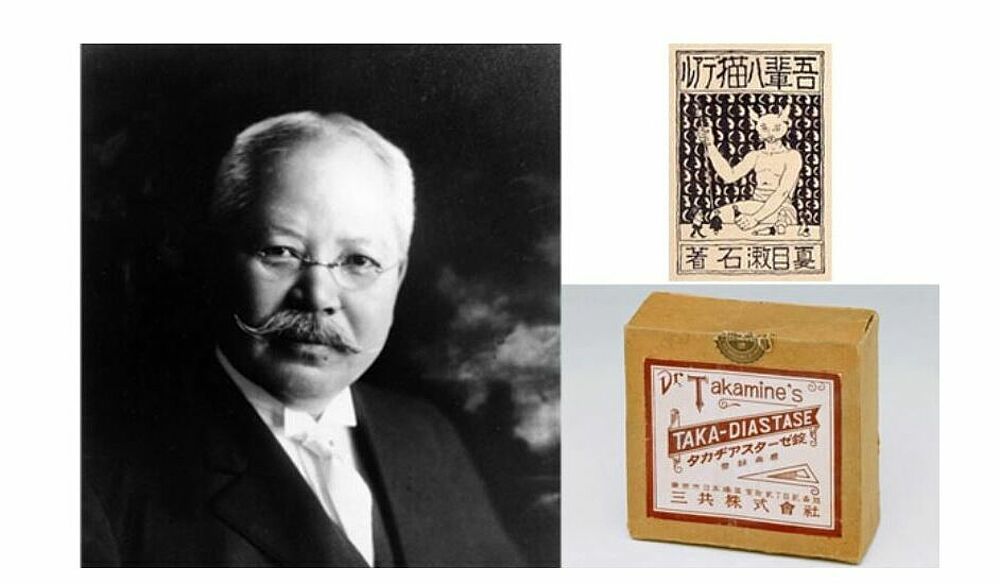
More than a century ago, the digestive enzyme Taka-Diastase was so popular that we can find it in the satirical novel, I Am a Cat (Wagahai wa neko dearu), written by one of Japan’s best-known novelists, Soseki Natsume, whose picture appears on the current Japanese 1,000 yen note. In an English translation of the novel, the following passage appears: He suffers from indigestion, and his sallow complexion tells of the want of elasticity and vitality of his skin. Nevertheless, he is a gormandizer. He eats his fill and takes the drug, “Taka-Diastase.”
The “He” in the novel is Mr. Kushami, who was modeled after the author himself. Like Mr. Kushami, Soseki is said to have been a frequent user of the popular digestive enzyme, Taka-Diastase, which is used to this day as an ingredient in the stomach medicine, "Daiichi Sankyo Ichoyaku” sold in Japan. Taka-Diastase was invented by Dr. Jokichi Takamine, the first president of Sankyo Co., Ltd. (Sankyo), one of the predecessor organizations of Daiichi Sankyo Co., Ltd. (Daiichi Sankyo).
Jokichi Takamine was born in 1854 in present-day Takaoka City, Toyama Prefecture, Japan. His father was a doctor who practiced the Dutch theory of medicine, which was first introduced to Japan in the early 1600s, and his mother came from a family of sake brewers. Influenced by his father, he aspired to become a doctor himself and studied “Occidental sciences and culture” in Nagasaki Prefecture, where he became interested in chemistry.
Dr. Takamine went on to study at the Imperial College of Engineering in Tokyo (presently the University of Tokyo’s Faculty of Engineering), and after graduating as the top student in his class, he studied in Scotland for three years on a government scholarship. Returning to Japan at the age of 28, Dr. Takamine became a high-ranking official at the Ministry of Agriculture and Commerce, working tirelessly to bring to Japanese agriculture and industry what he had learned in the UK during the heyday of the Industrial Revolution.
A short time later, Dr. Takamine started an artificial fertilizer company and at the age of 35 he developed a process to brew Scottish whisky using kome koji (malted rice). The production of kome koji whisky was revolutionary, promoting fermentation at a lower cost and within a shorter period of time compared to conventional whisky production with barley malt. In 1891, two years after a patent was issued in Scotland, he moved to Peoria, Illinois (USA) to start a company to further his research and development into whiskey (the American spelling) production.
When kome koji began to be used for his whiskey production, Dr. Takamine started receiving threatening letters from the producers of barley malt. Only two years after the company’s inauguration, its brand-new facilities in Illinois were destroyed by a mysterious fire. Dr. Takamine was overwhelmed by the destruction of his business and became seriously ill due to liver disease. Fortunately, he survived thanks to a bold move by his wife, Caroline, who brought him to a major hospital in Chicago some 160 kilometers away.
Even under such difficult circumstances, Dr. Takamine never lost his interest in research. While recovering, he came up with the idea that "the enzyme of koji mold (Aspergillus oryzae) might work in the human stomach as well and help with the digestion of starch.” This flash of insight resulted in the invention of Taka-Diastase.
After making a full recovery, Dr. Takamine visited a number of pharmaceutical companies, showing his sample Taka-Diastase. Parke-Davis (now Pfizer), a company that already had a worldwide sales network, came forward with an offer for commercialization. In 1895, Taka-Diastase was launched as a digestive enzyme in the US. It took little time for the highly effective and easy to consume medicine to gain worldwide popularity.
Taka-Diastase is no longer available as a prescription medication. However, its ingredients are used in over-the-counter drugs in Japan, such as "Shin Taka-Dia Tablets" and "Daiichi Sankyo Ichoyaku," which are manufactured by Daiichi Sankyo and are widely available.
Although more than 120 years have passed since Taka-Diastase was first released as a pharmaceutical product, the legacy of Dr. Jokichi Takamine's passion for innovation continues to be passed down to the modern-day research scientists of Daiichi Sankyo.
Enter your username and password here in order to log in on the website
Dear User,
if you want to login you accept our
cookie policy
.


